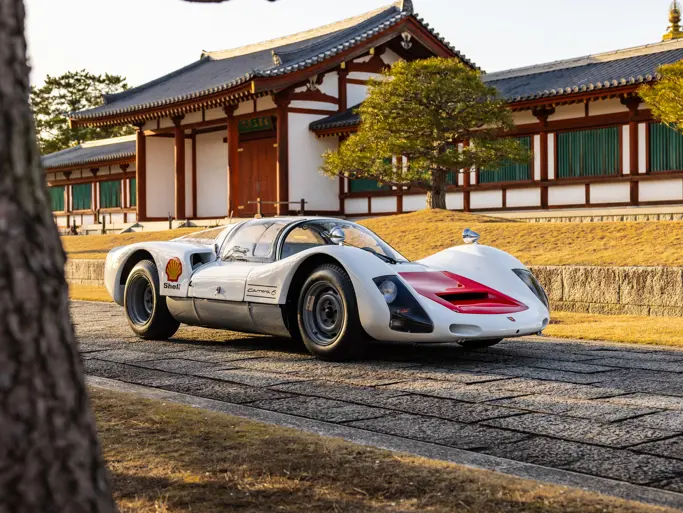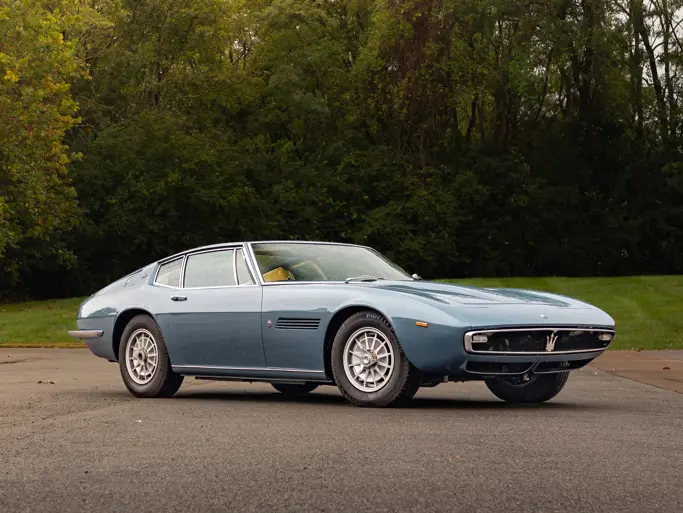Bearing a distinctive design from the pen of the renowned Virgil Exner, who is best remembered for his “Forward Look” Chrysler styling from 1955 to 1963; the Stutz Blackhawk exhibits a stand-alone styling that is based on the Pontiac Grand Prix platform of the era.
The Stutz Blackhawk was an American high-end specialty luxury car manufactured from 1971 through 1987. Other than the name, it bears no relationship with the original Stutz of the classic era. The Stutz Motor Company was revived in August 1968 by New York banker James O'Donnell. He joined forces with retired Chrysler stylist Virgil Exner who designed the new Blackhawk.
Exner's design included a spare tire that protruded through the trunklid (similar to the Imperial Crowns of the 1950s, without cover), a massive grille reminisce of cars of the classic era and isolated headlamps. The new Blackhawk was prototyped by Ghia in Italy at a cost of over $300,000. To offer exclusivity and still allow easy servicing in the United States, a custom-built Italian body was added to a GM platform and engine. The Blackhawk debuted in January 1970 at the Waldorf Astoria in New York City. Prices ranged from $22,500 to $75,000. All of the early Blackhawks were coupes, but rarely seen sedans were produced later. They named their convertible versions D'Italia and Bearcat.
The Blackhawk was met with enthusiastic response. During the course of their run, approximately 500 to 600 units had been manufactured by 1987. In 1972, the MSRP for the Blackhawk was for approximately $23,000 and the following year it was sold for around $43,000.
They have the signature trunk-mounted spare along with distinctive side exhausts. Inside are Connolly leather seats with front buckets that are power-operated and gold plated interior trim, including the instrument bezels. There is a console-shifted automatic transmission, air conditioning, chrome wire wheels, whitewall tires, dual sport mirrors, trunk release, CD player, rear window defogger, power steering and brakes, real wood interior trim elements from birdseye maple and Stutz Blackhawk-specific badging, also seen in gold.
With an extra-heavy gauge steel body handmade at Carrozzeria Padane in Modena, Italy, and from 1972 at Carrozzeria Saturn in Cavallermaggiore, near Torino, Italy; the handbuilt Blackhawk had 18 to 22 hand-rubbed lacquer paint coats that took six weeks to apply. Total production time for each vehicle was stated to be over 1,500 manhours. The overall length measures more than 19 feet; and the production model utilized Pontiac's 7.5-liter V-8 engine and a GM Turbo-Hydramatic 400 automatic transmission. The engine was reported as being tuned to produce 425-hp. Weighing 5,000 pounds, the Blackhawk could achieve 0- to 60-mph in just 8.4 seconds and had a top speed of 130-mph. Later in its production, Blackhawks used Pontiac's 403 and 350. Also Ford, Chevrolet and Cadillac engines were used. In 1980, the Blackhawk was redesigned for the Pontiac Bonneville chassis.
Along the way, Stutz Blackhawks became the car of choice among some of the most well-known entertainers of the day. Elvis Presley was the first to purchase the original production vehicle, and he liked the car and its statement so much, he eventually bought four more. Other elite owners included Evel Knievel, Sammy Davis Jr., Dean Martin, Wilson Picket, Robert Goulet, Larry Holmes, Jerry Lewis, Billy Joel, Lucille Ball, Elton John, Al Pacino, Frank Sinatra, Paul McCartney and many more prominent and wealthy enthusiasts.
These cars carry an inherent rareness factor due to the low build numbers and will continue to generate interest and conversation no matter where it may be seen or displayed.



 | Fort Lauderdale, Florida
| Fort Lauderdale, Florida


